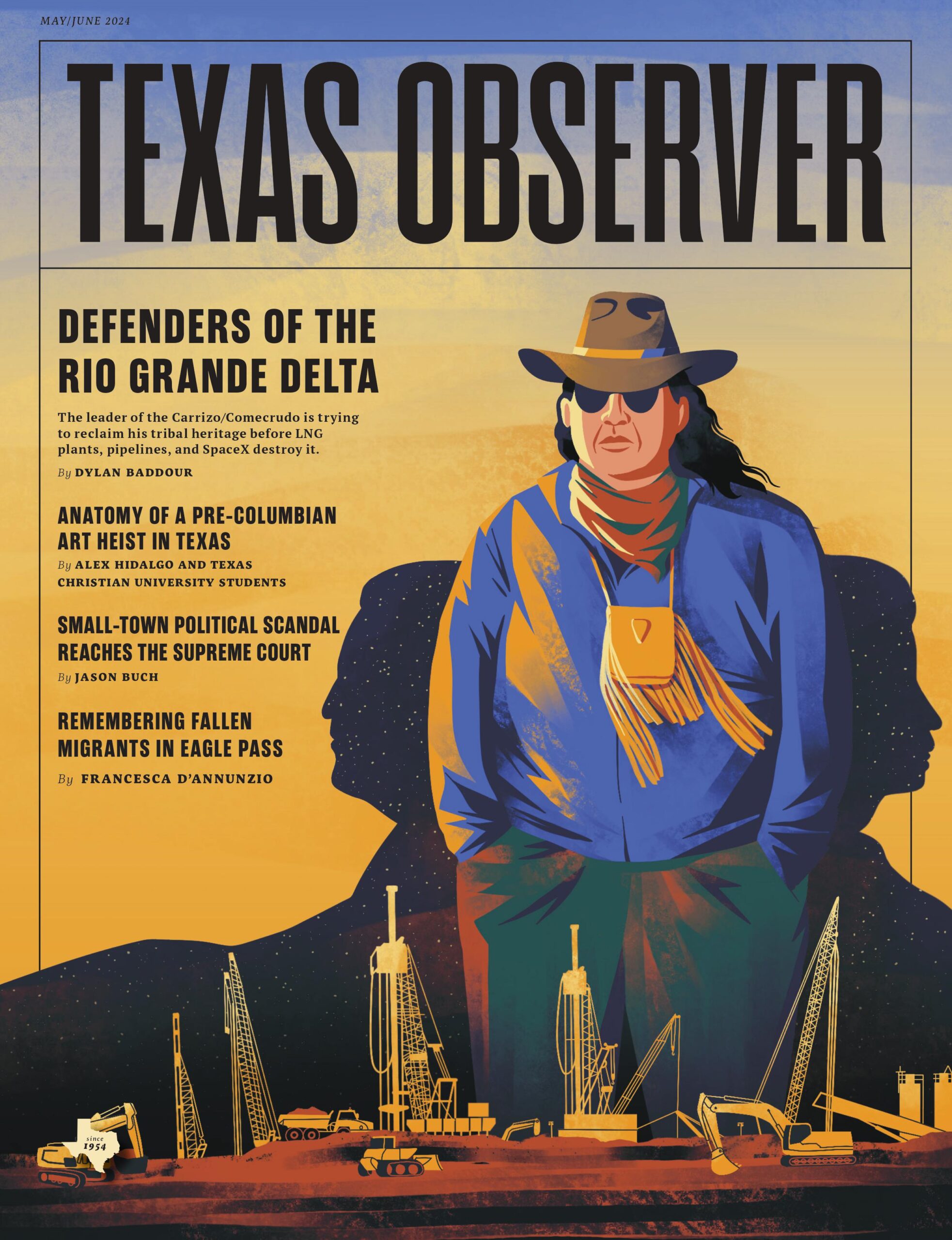ustxtxb_obs_1977_04_22_50_00017-00000_000.pdf
Page 38
Turkey Creek Unit Emma Temple .. Neches Bottom z Donation Sayttall Unit a ; le &Jack Gore Sandyland St 1 Laura Eisen hour but all it did was remove the top layer. Then the water dammed up by the remaining planking killed more than 50 acres of trees. Kirby Lumber, which owns the land, finally bulldozed the logjam at the urging of conservationists. By then the area was so swampy that the bulldozer itself was nearly lost. The road remains, pointing into the heart of the Rosier Unit, rotting under a coat of black plastic. Geraldine fished a box of Sucrets out of her purse and handed them over. With a rueful glance back at the Rosier Unit, Elizabeth explained that while she was beginning to get a headache, she didn’t have a sore throat yet. The Sucrets box had long ago been emptied of its lozenges, however. It was now full of bear claws that Geraldine had collected two years before near the much-violated Beech Creek Unit. The claws belonged to a year-old black bear found with a neat 22-caliber hole in its forehead. Apparently it had been shot by night hunters and had run off into the Thickets to die. Are there other bear in the region? No one knows for sure. Most wildlife specialists will tell you the black bear is extinct in East Texas. The Sucrets box disappeared in Geraldine’s purse. Monoculture We thanked Geraldine for bringing more joy into our beautiful spring day, but she interrupted to ask if we’d heard about the Blue Hill nuclear-power generator. It was scheduled to be built in Newton County in the early 1980s. The trouble for the Big Thicket, she said, was that the power-line corridors were going to be 200 feet wide and would cross three Thicket areas: the Upper Neches River corridor at Maple Slough, Village Creek at the Arid Sandland, and the Pine Island Bayou corridor below the Rosier Unit. Conservationists had long coveted Maple Slough, a beautiful cypress swamp and bottomland forest; the Arid Sandland, in turn, contained a dry, sandy area remarkable for its yucca cactus, and West Texas wildflowers. Temple-Eastex, at the urging of Arthur Temple Jr. was going to donate some 2,000 acres of it to Nature Conservancy as a preserve at an April 16th ceremony to be presided over by none other than Lady Bird Johnson. And now the projected power-line corridor was aimed for the middle of the new preserve. After they’d slashed Maple Slough and the Sandland, perhaps they’d manage to run the corridor clear across the whole Rosier Unit. After all, they already had a rotting plank road there to start off on. Maybe, someone else said, they could just stop construction of the nuclear generator. By now the land had started to roll. The swampy Lower Thicket was behind us, the upland pines were just ahead. Not long ago these had been natural forests, deep and varied. Even the cutover lands had largely regrown. Now the flats and low hills were being stripped of magnolia, maple, native pine and dogwood, and refurbished by monoculture: rows of slash pines, thousands of acres at a time, horizon to horizon. It took 250 to 400 acres of the stuff to support a single deer. And it supported little else, certainly few birds, no squirrels. A faint smell of pines and wet earth drifted in the windows as we turned off the highway. The road wound through hardwood bottomland laced with meandering clear streams, and then looped finally up a hill where wind-tossed pine boughs glistened in the early afternoon sun. We stopped before a brick ranch house. It would, Mickey suggested, make a fine retreat for nature writers and scientists, once the surrounding 92 acres were donated. The property belonged to Paul and Naomi Grubbs. They trekked us pa tiently around their acreage, a mixture of longleaf pine uplands and bottomland hardwoods. From the hilltops a panorama of piney hills rolled away into the hazy distance. Hogbacks, they’re called in Appalachia. They were miniatures of the broken ridges of the Cumberlands, but even as miniatures they left the impression of foothill country. Perhaps that is why so many Tennessee, Kentucky and North Alabama hill people had settled there. Their feuding had given the area the name of Scrappin’ Valley. As recently as twenty years ago there were feuds in these hills. “Why,” Geraldine exclaimed, “there still are. These people are miserable unless they are into some kind of fight.” The path wound slowly downhill through tousled grass and pine sapplings into a clearing guarded by a big lightning-blasted pine. At the center of the clearing stood the biggest dogwood any of us had ever seen. Its branches sprawled out for over 50 feet like some Louisiana live oak, covered with green moss. There were several trunks from a common center and we debated whether it was one tree or several. I opted for the One, Elizabeth for the Many. Ahead of us stood what we had come to see: the Hanging Bog. It was a steep hill, 60 or 70 feet high, strewn with deeply eroded sandstone boulders and grown up in tallgrass, wax-myrtle and longleaf pine. The hill was flat-topped as a mesa, and around its rim clear water seeped slowly down through insecteating pitcher plants, some of them two feet high. We straggled slowly to the top past club moss and fern and rocks splashed with burnt orange and brown and light-green lichens. It was a marsh at a 30 degree angle. I had not known that such things existed. Besides the pitcher plants, three other kinds of insectivores grew there, along with several species of ferns and orchids, and who knows what else. Many of these species had not regrown until the Grubbs had come and stopped cattle from grazing there. The hilltop was a desert. On its rocky, sandy soil a sprinkling of prickly pear cactus, wire grass and sandjack oaks grew, alongside a few stunted pines. We shook mud off our boots and sat down in the dust, watching our daughter chase moths, clasping at them with amazement. The sun was sinking. A buzzard cantilevered against the wind and spun away from us. For minutes we sat silently. “Listen,” Mickey finally said, “I’ve got some good news. Can you stand it?” “I’m not sure.” The good news concerned Knight, Inc., of Jourdanton. Knight had planned an ultratoxic dump on Pine Island Bayou, next door to the Hardin County High School and eight miles upstream from the Big Thicket Preserve \(Obs., Not only did the dump menace the preserve, it threatened the drinking water of Beaumont and promised to back water into the nearby town of Grayburg. It could be counted on to wreck property values in nearby subdivisions, too. It was a Brilliant Idea, but its time hadn’t come. The uproar caused by homeowners, the Big Thicket Association and others forced Knight to give up the dump site. Knight had selected another site, but refused to say where it was. Meanwhile, State Rep. Herman Adams of Silsbee had introduced HR 1697 to plug loopholes in the Texas Solid Waste Act, which made the indiscriminate siting of toxic-waste dumps possible. If the law could pass the Legislature this spring, it would be a little harder to wind up with a toxic wonderland in your back yard. “So,” she grinned, “there is good news. Of course, if Adams’ law doesn’t get passed, then any factory in Texas can April 22, 1977 17


